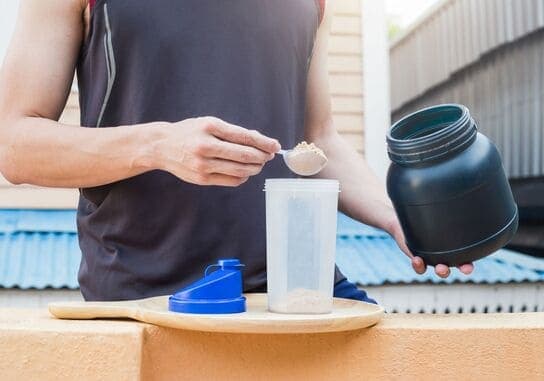Creatine Monohydrate Before and After

November 2, 2024
If you've ever stepped foot into a gym with the faintest ambition of lifting something heavier than a coffee mug, you've likely heard murmurs about creatine monohydrate. It's whispered about in locker rooms, splashed across fitness forums, and hailed by many as the secret sauce to athletic prowess. But what exactly is this mystical powder, and why do so many swear by it? Let's embark on a journey to uncover why creatine monohydrate is often considered the best creatine supplement out there.
The Humble Origins of a Powerhouse Supplement
Creatine monohydrate isn't some exotic substance concocted in a high-tech lab; it's a naturally occurring compound found in everyday foods like red meat and fish. Our bodies are quite familiar with it, producing creatine and storing it in our muscles as a quick energy reserve. So, why the need to supplement? Think of it as topping off your gas tank before a long drive—you’re ensuring there's plenty of fuel when you need that extra push.
The Science Made Simple
At its core, creatine plays a pivotal role in energy production during high-intensity activities. When you're sprinting, lifting, or performing any explosive movement, your muscles rely on adenosine triphosphate (ATP) for that immediate burst of energy. Creatine aids in the regeneration of ATP, essentially reloading your muscles' energy supply so you can maintain peak performance for longer. It's like having a backup battery that kicks in right when your primary one starts to wane.
Why Creatine Monohydrate Tops the Charts
With a plethora of creatine variants flooding the market—creatine ethyl ester, buffered creatine, creatine hydrochloride—it can feel like navigating a nutritional maze. Yet, creatine monohydrate remains the gold standard. Why? It's the most researched form, boasting a mountain of scientific studies that vouch for its effectiveness. It's not just about popularity; it's about proven results. When discussions arise about the best creatine, monohydrate invariably leads the conversation.
Charting the Course: Before and After Creatine Monohydrate
Embarking on a creatine regimen is akin to starting a new fitness chapter. Here's what you might expect along the way.
The Initial Weight Gain: A Sign of Good Things Ahead
Before: Perhaps you're vigilant about the scale, wary of any upticks.
After: Don't be alarmed if you notice a 1-3 pound increase within the first week. This isn't fat gain; it's your muscles holding onto more water—a positive indicator that creatine is saturating your muscle cells and gearing up to boost your performance.
Breaking Through Performance Plateaus
Before: You've been grinding away but can't seem to lift heavier or run faster.
After: Many users report a noticeable surge in strength and power output after just a few weeks. Suddenly, those weights feel a tad lighter, and those extra reps seem within reach.
Amplified Muscle Growth Over Time
Before: Progress in muscle development feels painstakingly slow.
After: With enhanced training capacity and better recovery, muscle gains become more pronounced. It's not overnight transformation, but a steady, satisfying journey of visible results.
Swifter Recovery Between Workouts
Before: Post-workout soreness lingers, making it tough to stick to your training schedule.
Our Top Recommendations

Optimum Nutrition Micronized Creatine Monohydrate Powder
Micronized for easy mixing, supports muscle growth and endurance.
See on Amazon$0.35 per 5g serving

Nutricost Creatine Monohydrate Micronized Powder
Third-party tested, non-GMO, 5g of pure creatine per serving.
See on Amazon$0.2 per 5g serving

NSF Certified, supports muscle power and recovery.
See on Amazon$0.46 per 5g serving

ProMix Creatine Monohydrate Powder
Micronized, additive-free, ideal for performance and recovery.
See on Amazon$0.36 per 5g serving

NOW Foods Sports Nutrition Unflavored
100% pure creatine, GMP certified, boosts strength and endurance.
See on Amazon$0.2 per 5g serving
After: Creatine can mitigate muscle cell damage and inflammation, helping you bounce back quicker and stay on track with your fitness goals.
Maximizing the Benefits: How to Use Creatine Monohydrate Effectively
To truly harness the power of creatine, a strategic approach is key.
Nail the Dosage and Consider a Loading Phase
- Loading Phase: Kick off with 20 grams per day, divided into four doses, for the first 5-7 days to saturate your muscles rapidly.
- Maintenance Phase: Transition to a steady 3-5 grams per day to keep your creatine stores topped up.
Consistency is Your Ally
- Daily Routine: Take creatine at the same time each day to maintain consistent levels.
- With Meals: Pairing creatine with a meal, especially one rich in carbohydrates, can enhance absorption.
Hydration: More Crucial Than Ever
- Stay Hydrated: Creatine increases water retention in muscles, so it's vital to drink ample fluids to support this process and overall health.
Pair Creatine with a Solid Training Program
- Effective Workouts: Creatine amplifies your training capacity, but it doesn't replace the need for a well-structured resistance training regimen.
Patience and Progress Tracking
- Monitor Your Journey: Keep a log of your workouts, noting improvements in strength, endurance, and muscle size.
- Long-Term Vision: Significant changes unfold over months, so stay committed and patient.
The Final Word: Is Creatine Monohydrate the Best Creatine for You?
In the ever-evolving landscape of fitness supplements, creatine monohydrate stands out—not as a fleeting trend, but as a time-tested ally backed by science and success stories alike. Its ability to enhance strength, muscle growth, and recovery makes it a compelling choice for those serious about elevating their fitness game.
So, is it the best creatine supplement available? Many athletes and gym-goers would give a resounding yes. But ultimately, the best supplement is one that aligns with your goals, is backed by research, and fits seamlessly into your lifestyle.
Ready to experience the potential benefits firsthand? Adding creatine monohydrate to your supplement stack might just be the catalyst for the progress you've been striving for. Embrace the journey, track your results, read more articles, and join the vibrant community of individuals pushing their boundaries.






